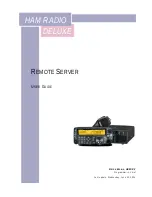
Storage
The QuVIS Acuity is configured with 4 internal and external LVD SCSI buses or channels, each capable of
supporting up to 14 devices including: internal SCA media drives, hot-swap removable hard drives and 8mm data
tape drives. Internal media drives are used to record and play video and audio in real-time. Removable hard drives
may also be used to record, play and archive content or to share content between similarly equipped QuVIS video
servers. Tape drives (Sony AIT) may be used to create an off-line archive of content for long-term storage or to
share content between units.
QuVIS internal hard drive media storage is configured to stripe data across multiple hard drives, with each drive
residing on its own SCSI channel, configured as a single storage volume. For storage and bandwidth flexibility,
QuVIS video servers support various drive volume widths. The number of drives in a storage volume can vary,
depending upon determined bandwidth requirements, from one to four drives in a QuVIS Acuity. A single-drive
volume can be used to transport and share content between QuVIS video servers or to play content that is data-
rate limited, either by the video format, such as NTSC or PAL, or by QuVIS data-rate controls. A single-drive
volume will support a Maximum Data Rate (MDR) of 30MB per second or MDR30.
Multi-drive volumes may be used to store and playback high data-rate content such as the video format 720p60.
Multi-drive volumes may also be used to create very large storage volumes capable of recording many hours of HD
content on a single volume. The maximum data rate two-drive volumes can support on a QuVIS Acuity is limited to
60MB per second or MDR60.
Drive order within a “non-boot” volume is not important, as volume order is determined during the formatting
process. Once a volume is formatted, the user may remove the volume and place the drives back into the QuVIS
Acuity or a different Acuity, QuVIS Acuity or QuVIS Cinema Player in any order. The system will automatically
identify which drive is the proper logical drive in the stripe sequence. This auto-sequencing feature is very useful
when using hot-swap removable drives allowing the operator to concentrate on the process and not the sequence
of drives that make up a volume.
Placement of a “boot” volume, volume that contains the system operating software, is important. The boot volume
should always be placed starting in the left-most two positions of the Internal Media Bays. Removing the boot
volume from the system will render the unit inoperable from a video record and playback standpoint. If a valid boot
volume is not detected the unit will still power on but the operating system will have limited functionality and
playback will be disabled.
To ensure that drive failure does not interrupt a mission critical workflow the QuVIS Acuity can be attached to a
highly reliable redundant external storage array, called a RAID array. RAID storage, or Redundant Array of
Inexpensive Disks, can be configured such that a single drive failure will not impede the ability to play content.
Using external storage arrays the QuVIS Acuity can support multiple Terabytes of online storage.
Volume Sizes
Internally, the size of storage volume can vary depending upon the size of the drive and the number of drives in the
volume. Externally, the QuVIS Acuity can support even larger volume sizes, up to multiple TeraBytes (TB) of
storage, using approved multi-channel drive arrays.
Internal Media Bay Storage
The latest video server products from QuVIS (QuVIS Ovation, QuVIS Cinema Player, QuVIS Encore and QuVIS
Acuity) offer new internal storage architecture designed to enable front panel access to internal Media storage. This
new architecture allows QuVIS Media storage to be shared between these products by simply removing a volume
from one machine and placing it in the Media bay on another.
The QuVIS Acuity has eight internal Media storage bays. Each Media bay accepts SCA (Single Connector Adapter)
SCSI hard drives that are mounted on removable drive slides. Media drives are hot-swappable meaning that they
may be inserted or removed while the unit is powered on. SCSI device ID assignment is handled automatically by
QuVIS Acuity
™
Page 44
QSR Version 3.3
Summary of Contents for Acuity
Page 1: ......
Page 152: ...Keyboard Hotkeys Description ENTER Complete current edit QuVIS Acuity Page 151 QSR Version 3 3...
Page 190: ...QuVIS Acuity Page 189 QSR Version 3 1...
Page 200: ......
















































